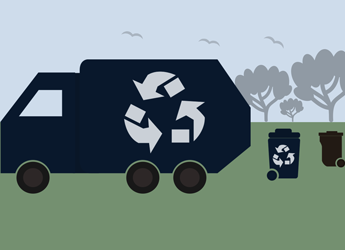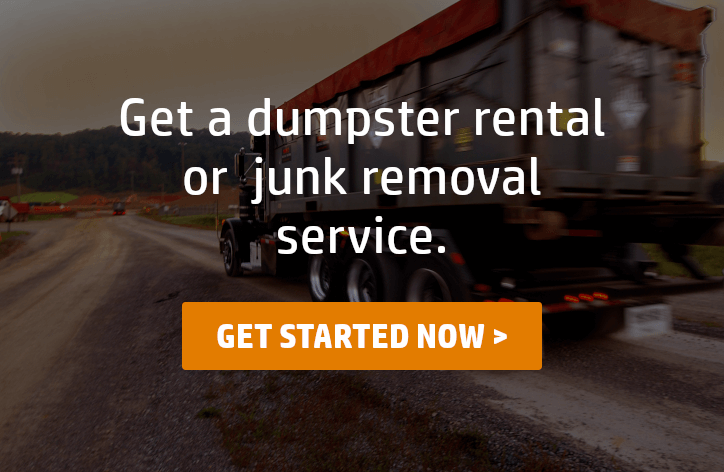Recycling Matters
Where does America’s garbage go? The average American throws away about 7.5 pounds of garbage every day. In most cases it goes to one of the approximately 1,900 solid waste landfills in the United States. The practice of landfilling garbage has been used in the U.S. since 1937, and has been closely governed by regulations since the U.S. Congress passed the Solid Waste Disposal Act in 1965.
Landfilling is Costly
Landfills are exceptionally expensive to site and operate. First, landfills can only be located in certain areas; generally away from highly populated zones and outside of floodplains, etc. By 1979, regulations from the USEPA outlined newer criteria for landfills. Now landfills must adhere to the following: (1) they cannot contribute pollution to surface waters (rivers, lakes, and streams) or groundwater; (2) they must institute disease and vector control (controlling rodents, birds, and insects); (3) they must control explosive gases (such as methane); (4) they must control open-burning/prevent fires within the landfilled materials; and (5) they must protect endangered species.
Additionally, landfills are required to cover each day’s layer of garbage with at least 6-inches of topsoil (known as daily-cover). As a part of a landfill’s groundwater protection plan, their disposal cells are required to have plastic liners to prevent rainfall from flowing through the waste to form “leachate” that might pollute the nearby water table. This leachate must instead be pumped and appropriately treated. Landfills must also have groundwater monitoring plans to test the groundwater around the landfill to make sure no toxic leachate might be impacting drinking water sources. Landfill operators must also have plans in place for eventual closure and post-closure monitoring care, along with the financial resources to underwrite such care.
Recycling as an Alternative to Landfilling
What about alternatives to expensive and often undesirable (i.e., “not in my back yard”) landfilling? The answer can be found in recycling waste instead of simply throwing it away.
Recycling is the process of changing waste materials into new products. Recycling helps prevent the waste of potentially useful materials, and reduces the consumption of fresh raw materials. Recycling materials helps reduce energy usage, reduce air and water pollution, and lower greenhouse gas emissions (thereby positively impacting climate change). Recycling also helps conserve valuable space in the nation’s remaining landfills—less waste being tossed in landfills means a landfill has more useful life in it.
Recycling is a key component of modern waste reduction and is the third component of the waste-reduction hierarchy known as “Reduce, Reuse and Recycle,” or the “3Rs.” As of 2009, recycling in America was a $236 billion a year industry that facilitates more than 56,000 recycling and reuse enterprises employing 1.1 million workers nationwide.
The Three Steps of Recycling
There are three steps to recycling. The first step is the separating and collecting of the materials to be recycled. Separation of materials is followed by processing them so they can be reused, which is followed by remanufacturing the processed recyclables into new useful goods.
Collection and Separation of Recyclables
Collection and separation of recyclables happens in different ways. The rules governing collection and separation can be determined at either the State or local level (or both), depending on where you live. In some places, people must sort and take their recyclables to a collection site (for instance, at a shopping center parking lot) where there might be separate bins for paper, aluminum, plastics, glass, metals other than aluminum, etc.
Other areas use what is called “curbside recycling” whereby recyclables are picked-up on a regular basis; often on the same day as your scheduled garbage pickup. Curbside recycling frequently requires some sort of separation prior to pick-up. In some places, all recyclables are placed into one large can, which is then collected separately from garbage going to the landfill, and sorted at another location.
In some localities, private waste-recycling firms will actually buy-back your waste paper, aluminum, or other recyclables at a collection-center, usually paying a set fee per pound of materials. They then re-sell the recyclables to industries needing the material.
Manufacturers have taken some steps to make sorting and collection easier. For instance, plastics are identified by codes developed by the Society of Plastics Industries (SPI). The SPI codes identify seven categories of plastics, according to type. The triangle with a number in it molded onto the bottom of your used plastic bottle is the Resin Identification Code and tells you that the plastic in the item is recyclable. The code represents what type of resin the plastic is made of; for instance, a triangle with the number “05” inside indicates that the bottle is made out of polypropylene, and code “06” denotes it is made out of polystyrene.
Processing and Re-Manufacturing
After collection, the recyclables are processed for reuse. Depending on the recycled material, processing can include sorting, washing, drying, grinding, or heating. Some novel processing methods even include dissolving by chemical means.
Some plastics are simply ground and then heated and reformed into new containers. In these instances, used milk jugs may be recycled into detergent bottles. One plastic recycling technology breaks down the plastic via a chemical “depolymerization” process, which removes all impurities so clean monomers can be reused; or, it breaks the plastic down into multiple chemical precursor products which can then be re-purposed.
Metals are typically re-smelted so they can be molded into new products. Most steel cans contain about 25% recyclable content, while aluminum cans can be 90% recycled.
Glass is usually ground into granules, termed “cullet.” The cullet can then be melted and formed into new glass products. In some cases, the cullet is mixed into asphalt to serve as a binder. The resulting product is called “glassphalt.”
Paper is typically ground into fibers and then run through a de-inking process. The fibers are then recycled into paper and cardboard, with the product usually labeled “paperboard.” Recycled paperboard is used in the packaging of many items. Often, you will see a designation indicating that “this package contains X% recycled content”, which denotes how much recycled material is in the paperboard for the packaging material. Recycled paper is often used in the boxes used for cereals, macaroni and cheese, and cake mixes. If the inside of a box is gray or brown, it is likely that it is made of recycled paper.
Making Recycling Work
In order to have a successful recycling program, all steps of the recycling process must work in harmony. First, people must have enough interest in recycling to participate—or at least not complain about having to recycle where statutes and regulations make participation mandatory. Recycling can actually be fun and interesting, especially when your collection of recyclables starts to exceed the portion of your waste going to the landfill. Once the recycling program begins in earnest, facilities must be available to process the materials collected. Finally, industry must be available to make the recycled materials into new products. Key to the success of all of this is: People must be willing to purchase and use products made from recycled materials. This last point is called “closing the loop.” Closing the loop is very important, because if there is no end market for the recycled materials to go to, it defeats the original purpose of recycling.
Why It’s Important to Recycle
Recycling is a great way to help the Earth and its environment. Think of the 3Rs—Reduce, Reuse and Recycle. By recycling your waste products instead of just throwing them away you are reducing the pressure on the Earth’s finite natural resources and doing your bit to sustain a clean and safe living environment. You are also reducing the amount of energy needed to make raw materials into usable products; thus making a positive impact on climate change. You are also encouraging the reuse of perfectly salvageable materials which can be re-manufactured into other products. Finally, by buying and using products made from recycled materials yourself, you are closing the loop. A vigorous market for products incorporating recycled materials will only encourage manufacturers to create more such products for consumers.


